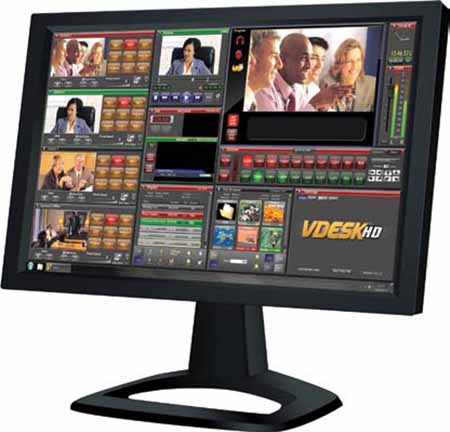Virtual Broadcasting
OTTAWA

Rushworks Vdesk HD —Advances in recent years in integrated channel playout systems—along with the advent of OTT services—are shaking the foundations of traditional brick-and-mortar broadcasting.
Now, with cloud-based channel-in-a-box systems, broadcasters don’t even need physical broadcast facilities beyond a Web-connected PC, according to Stephen Smith, cloud chief technology officer for Imagine Communications in Dallas.
“Theoretically, you can ingest and manage all of your content in the cloud, and then transmit it to your viewers via the Internet,” he said. “You could also send this same content stream, as a baseband signal to a cable TV or satellite provider, or even a broadcast antenna. The point is that you are no longer required to have a physical broadcast facility to be a broadcaster anymore.”
GROWING CAPABILITIES
Originally, CiAB systems like Florical Systems’ Acuitas, Harmonic’s Spectrum ChannelPort, Grass Valley’s Stratus (which evolved from Miranda’s iTX), Imagine Communications’ Versio, Snell ICE and Vdesk/A-list from Rushworks were aimed at simplifying single channel operations by putting all the ingest, traffic, scheduling and other playout management tools into a single automated hardware system; in other words, a “box.” In doing so, these manufacturers made it possible for broadcasters to significantly reduce their per-channel manpower needs; allowing them to cut costs and improve centralized control while maintaining or even improving on-air presentation quality.
“This combination is very popular with dozens of our customers, especially the PEG channels who use Vdesk for producing their meetings, and A-List for channel automation,” said Rush Beesley, president of Rushworks in Flower Mound, Texas. “You can stream directly from either/both Vdesk and A-List using the included flash media live encoder configuration.”

Stephen Smith, CTO, Imagine Communications In 2013, when TV Technology examined CiaB’s cost-cutting effectiveness for broadcasters such as Virginia’s Commonwealth Public Broadcasting and Fox Sports 1 (“More Than Just a ‘Channel in a Box’”; Nov. 11), such CiaB systems were heralded for their multifunctional capability; embracing so many aspects of TV broadcasting that Tim Mendoza, then director of playout for Imagine Communications (now vice president of product development), described them as being “a totally different paradigm than throwing up a $6,000 box and running a channel.”
The professional video industry's #1 source for news, trends and product and tech information. Sign up below.
One year later, and integrated channel playout (ICP) systems—as these vendors now call their CiaB systems—are going to the next level. For example, Florical’s Acuitas combines all functions of content ingest, on-air control, and asset management; including traffic control, remote system control from any authorized workstation, and real-time electronic program guide generation. “You can do all of this using off-the-shelf equipment,” said Shawn Maynard, vice president and general manager for Florical Systems in Gainesville, Fla. “We use HP servers and Matrox video cards.”
Harmonic recently struck a deal with U.K.-based automation provider Pebble Beach Systems to integrate the latter’s automation systems with Harmonic’s Channel-Port, to offer more comprehensive ingest, playout, and graphics/branding capabilities on ChannelPort. “The partnership allows our customers to buy ChannelPort systems that have been enhanced with Pebble Beach’s full range of automation tools,” said Andy Warman, director of product management, production and playout for Harmonic in San Jose, Calif. “This will allow them to manage multiple channels from a single centralized location.”
Imagine Communications now offers the CiAB capability found in its Versio hardware solution in the cloud, through Versio Cloud. The difference between the two is that Versio Cloud is software-based, while Versio combines hardware and software. “It is worth noting that the Versio Cloud uses whatever ‘cloud’ you wish,” said Smith. “It doesn’t have to be a third-party provider: You can define the cloud to be your own in-house server farm.”

Snell ICE
Meanwhile, Snell’s ICE ICP can provide platform-specific outputs or automatically reversioned content, according to Ian Young, product specialist for Snell’s TV Everywhere platform. This can include swapping rights-restricted content out on a specific platform at the source, adding SCTE 104 triggers to allow content switching remotely, or embedding “audience measurement identifiers such as Nielsen or Civolution into the output so that viewers’ consumption of that content is accurately recorded for revenue purposes,” Young noted.
CHANNELS AS NEEDED
In the past, broadcasters needed large, complex physical facilities to receive, edit, store, playout, and transmit their content. This is why over-the-air broadcasting was reserved for major TV networks, deep-pocketed independents, and public TV stations with enough cash to pay their facility and electricity costs.
Today, things have changed. Using ICP and the Web, it is possible for startups to mount new OTT channels with a minimum of facilities and money; and to switch off those channels when they cease to be promising or profitable. “The online Olympic channels provided during the 2014 Sochi Games are a perfect example of what can be done today,” said Smith. “Once the reason for operating the online channels is done, you just switch them off.”
Granted, the Sochi TV online channels relied on a lot of traditional broadcasting hardware, but there is no reason that new channels cannot be economically launched online using ICP and OTT; whether by start-ups or established broadcasters looking for additional audiences.
“You can be using ICP to take an existing channel feed and completely redo the graphics and branding in real-time, to feed it to other markets,” said Maynard. Beasley added, “This integrated production/automation platform reduces staffing and operator requirements, consolidates workflow, and enhances the opportunity for return on investment.”
All told, the combination of ICP and OTT are changing the fundamentals of TV content delivery. “We are going to see a huge shift in how TV broadcasting is done, going forward,” said Smith. “Those who get in on ICP/OTT will keep up with the changes taking place. Those who don’t, risk being left behind.”
James Careless is an award-winning journalist who has written for TV Technology since the 1990s. He has covered HDTV from the days of the six competing HDTV formats that led to the 1993 Grand Alliance, and onwards through ATSC 3.0 and OTT. He also writes for Radio World, along with other publications in aerospace, defense, public safety, streaming media, plus the amusement park industry for something different.

